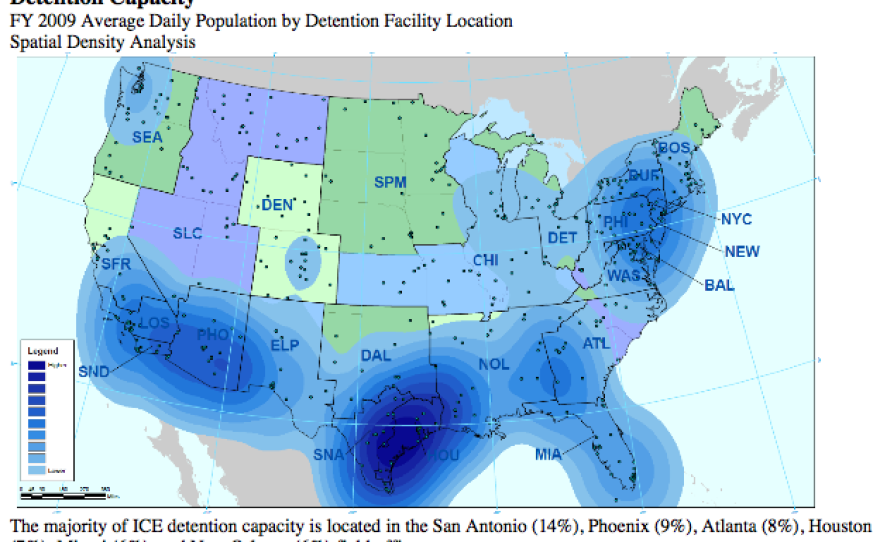A decision by Immigration and Customs Enforcement to release hundreds of immigrants from its custody who are awaiting deportation proceedings has sparked mixed reactions.
The agency says it took the cost-saving step in order to stay within budget because of the looming possibility of sequestration.
On Tuesday, ICE released figures that 303 immigrants have been moved in recent days from Arizona detention facilities to less costly forms of supervised release. The releases represent less than 12 percent of the total number of immigrants detained in Arizona.
Immigrants have been released from facilities all over the country, but national figures could not be confirmed by ICE on Tuesday. The agency instead said it has “reviewed several hundred cases.”
All immigrants who have been released will still face deportation proceedings in immigration court.
The move drew criticism from Arizona Governor Jan Brewer and Senator Jeff Flake. Brewer said releasing detainees at this point was "the height of absurdity" since sequestration cuts have not yet taken effect.
Pinal County Sheriff Paul Babeu also blasted the release. His county is home to multiple immigration detention facilities.
“This is, I fear, likely a weapon in a political fight over sequestration,” he said.
Babeau was also upset that ICE leadership was not immediately transparent about the release, which began Thursday.
He said instead, “over a dozen” ICE officers privately alerted him beginning Friday about the orders they were receiving from superiors to release certain immigrant detainees.
“For them to be just released, and not tell the local police chiefs, to not tell the local sheriffs, and then for us to have to drag the truth out of them, not only is this not transparent, this does create a public safety concern,” Babeu said.
Immigration detention is separate from the criminal justice system. It is used to ensure defendants facing deportation show up for court and leave if they are ordered removed from the country. While certain immigrants facing deportation with criminal records in their past are required by law to be detained, not everyone in immigration detention has a criminal record beyond alleged immigration violations.
Tucson immigration attorney, Jesse Evans-Schroeder said the majority of her clients who are held in ICE detention facilities in Arizona have either no criminal record, or only minor crimes in their past.
“We are unsure why they were detained in the first place given that ICE has said they are focusing their detention and removal priorities on criminal aliens,” Evans-Schroeder said.
She has four clients who were released over the weekend. She says the reason they had been in detention was a question of resources — each had been granted bond by an immigration judge previously, but couldn’t pay it to get out.
“Therefore an immigration judge determined that the person was not a danger or a flight risk and they merited a bond,” Evans-Schroeder said. “But they were unable to pay that bond. So they were languishing in detention at a cost to the government for no real purpose.”
Immigrant rights advocates have long pushed the administration to scale back the practice of detaining certain immigrants who are awaiting a conclusion to their immigration cases in court.
While many advocates welcomed the news that hundreds of detained immigrants had been released, some said they were disappointed it took a budget crisis to force the change.
“It shouldn’t take a manufactured crisis in Washington to prompt our immigration agencies to actually take steps towards using government resources wisely or keeping families together,” Carolina Canizales of the national advocacy group United We Dream said in a written statement.
Lindsay Marshall directs the Florence Immigrant Rights and Refugee Project, which represents immigrants who are detained at the Eloy and Florence detention facilities in immigration proceedings.
“This announcement and releasing people in this way for me is a confirmation of how many people we are holding in custody that don't need to be there,” Marshall said.
Nationally, ICE has around 34,000 detention beds. In 2009, 9 percent of the national detention capacity was centered in Arizona facilities, and 14 percent in South Texas, according to a report for the agency.
Secretary of Homeland Security Janet Napolitano had warned of the possible impact of sequestration on detention capacity in a congressional hearing earlier this month.
“Under sequestration, ICE would be forced to reduce current detention and removal operations, potentially affecting public safety, and would not be able to maintain 34,000 detention beds as mandated by Congress,” she said in written testimony to the House Appropriations Committee.
A detention bed costs can cost well over $100 a day compared to less than $14 for alternatives like ankle bracelets or telephonic monitoring, according to an ICE fact sheet.






